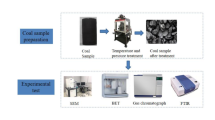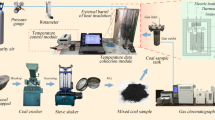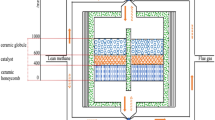Abstract
AT temperatures below 300° C the rate of oxidation of coal and char decreases with increasing time of oxidation, or alternatively with increasing extent of oxidation. Two types of equations have been widely used to represent the experimental curves relating the rate of oxygen uptake dq/dt to the time t or the total uptake q where D, E, F and G are constants for a given set of experimental conditions. Carpenter and Sergeant3 have observed deviations from the Elovitch type equation and suggested that they result from fresh sorption sites being created by the evolution of the gaseous oxidation products during the oxidation of coal.
where D, E, F and G are constants for a given set of experimental conditions. Carpenter and Sergeant3 have observed deviations from the Elovitch type equation and suggested that they result from fresh sorption sites being created by the evolution of the gaseous oxidation products during the oxidation of coal.
This is a preview of subscription content, access via your institution
Access options
Subscribe to this journal
Receive 51 print issues and online access
$199.00 per year
only $3.90 per issue
Buy this article
- Purchase on SpringerLink
- Instant access to full article PDF
Prices may be subject to local taxes which are calculated during checkout
Similar content being viewed by others
References
Schmidt, L. D., and Elder, J. L., Indust. Eng. Chem., 32, 249 (1940).
Wood, T., J. App. Chem., 8, 565 (1958).
Carpenter, D. L., and Sergeant, G. D., Fuel, 45, 311 (1966).
Taylor, H. A., and Thon, N., J. Amer. Chem. Soc., 74, 4169 (1952).
Author information
Authors and Affiliations
Rights and permissions
About this article
Cite this article
NEWMAN, J., STANLEY, L., EVANS, P. et al. Kinetics of Low Temperature Oxidation of Coal and Char. Nature 213, 280 (1967). https://doi.org/10.1038/213280a0
Issue date:
DOI: https://doi.org/10.1038/213280a0
This article is cited by
-
Zur Bestimmung Reaktionskinetischer Parameter der Kohleoxydation
Journal of Thermal Analysis (1973)



